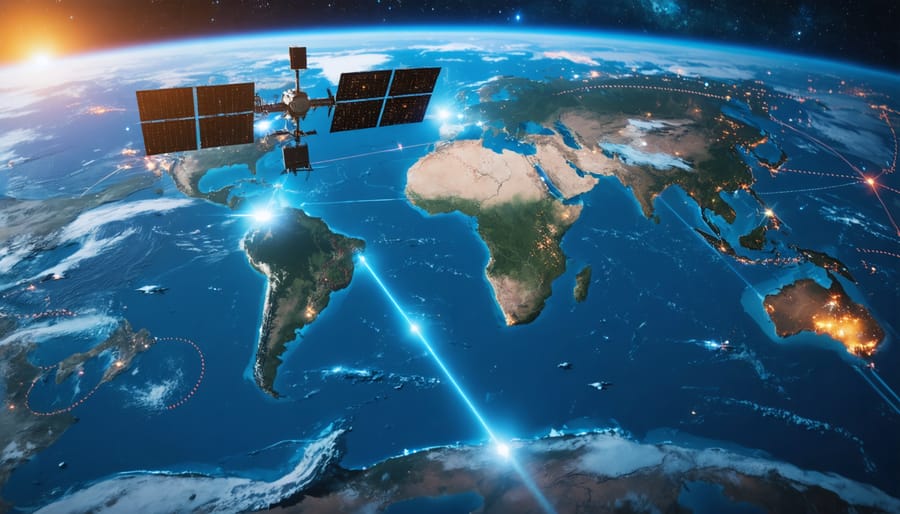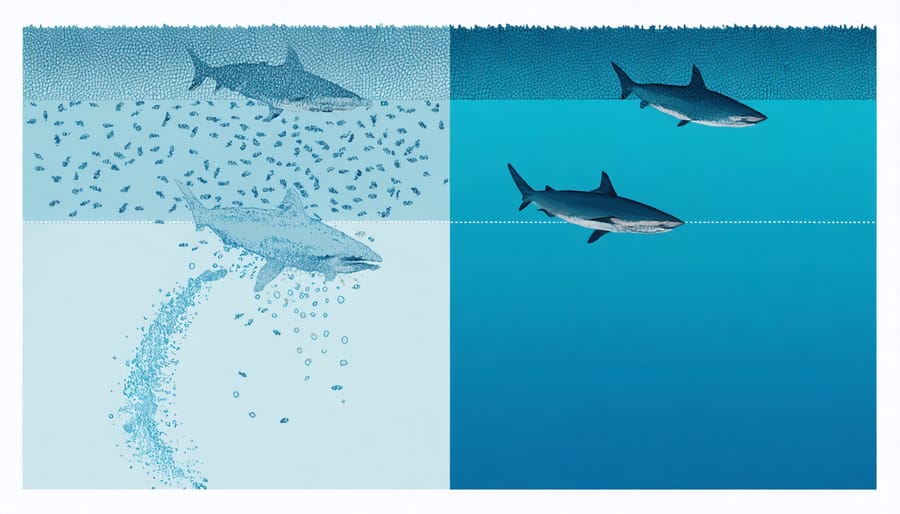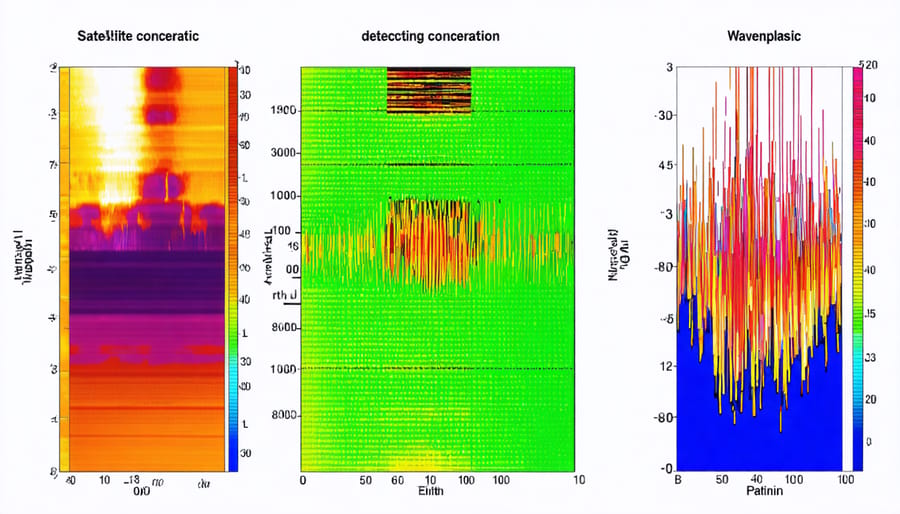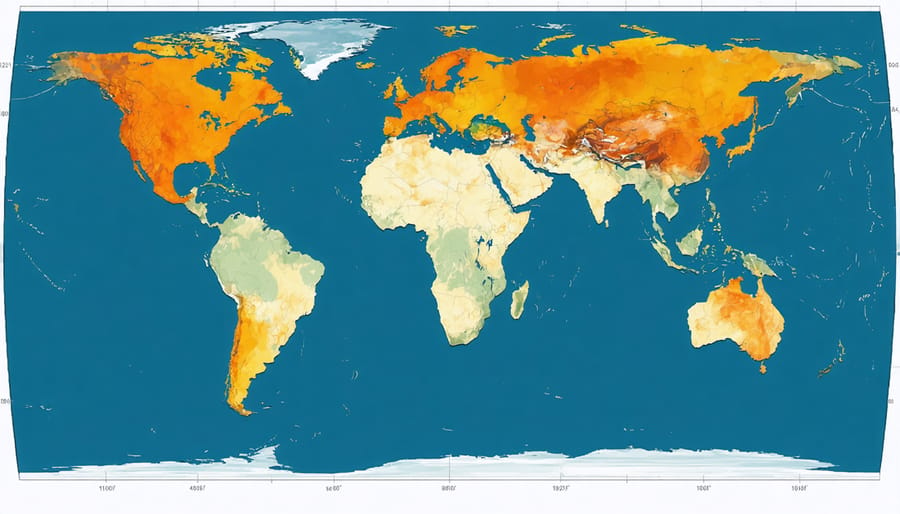
Beneath the glittering surface of our oceans lies an invisible threat that has captured the attention of scientists worldwide: microplastics. These tiny plastic particles, smaller than 5 millimeters, have infiltrated every corner of our marine ecosystems, challenging our ability to effectively monitor ocean health. Recent breakthroughs in satellite technology have revolutionized our approach to detecting and tracking these elusive pollutants, offering unprecedented insights into their distribution and movement patterns across global waters.
Using advanced spectral imaging and machine learning algorithms, scientists can now identify microplastic concentrations from space with remarkable precision. This technological leap forward represents a quantum shift in our understanding of plastic pollution, enabling researchers to map contamination hotspots, track pollution sources, and assess the effectiveness of cleanup efforts in real-time.
As we stand at the intersection of environmental crisis and technological innovation, these new detection methods provide hope for more effective conservation strategies. By combining satellite observations with on-site sampling and citizen science initiatives, we’re building a more comprehensive picture of microplastic pollution than ever before, empowering both scientists and communities to take informed action against this growing environmental challenge.
The Revolution in Microplastic Detection
Traditional vs. Satellite Detection Methods
Traditional microplastic detection methods typically involve direct water sampling, where researchers collect water samples from various ocean depths and filter them to identify plastic particles. This process, while accurate, is time-consuming and limited in scope, often covering only small areas at a time. Scientists must physically travel to collection sites, sometimes spending weeks at sea to gather sufficient data.
Satellite technology, however, is revolutionizing how we track and monitor microplastic pollution. Advanced sensors can now detect specific spectral signatures associated with plastic accumulation, enabling researchers to survey vast ocean areas within hours. These satellites use specialized imaging techniques that can identify plastic concentrations by analyzing how sunlight reflects off the ocean’s surface.
While satellite detection offers unprecedented coverage and real-time monitoring capabilities, it works best in combination with traditional methods. Ground-truthing through conventional sampling remains essential for validating satellite data and understanding microplastic composition at a microscopic level. This hybrid approach leverages the strengths of both methods: the broad perspective of satellite monitoring and the detailed accuracy of direct sampling, creating a more comprehensive understanding of global microplastic distribution.

How Satellites Spot Microplastics
Satellites equipped with advanced optical sensors and spectral imaging technology are revolutionizing how we track microplastic pollution in our oceans. These orbital platforms use specialized multispectral cameras that can detect the unique spectral signatures of plastic materials floating on or near the ocean’s surface.
The detection process relies on how different materials reflect and absorb light. Microplastics have distinct reflection patterns in both visible and infrared wavelengths, which satellites can identify and distinguish from water, organic matter, and other materials. This technology is particularly effective when combined with machine learning algorithms that can process vast amounts of data to create accurate pollution maps.
Recent advances in hyperspectral imaging allow satellites to detect plastic particles as small as 5 millimeters across. The satellites analyze subtle variations in light reflection across hundreds of spectral bands, creating detailed “fingerprints” of different types of plastics. This data helps researchers track the movement of microplastic concentrations, identify major sources of pollution, and understand how ocean currents affect their distribution.
While satellite detection isn’t perfect – factors like cloud cover and ocean turbidity can affect accuracy – it provides invaluable broad-scale monitoring capabilities that complement traditional sampling methods.
Current Satellite Technologies in Action
Spectral Analysis Techniques
Satellites equipped with advanced spectral imaging technology are revolutionizing our ability to detect and monitor microplastics in marine environments. These systems utilize various wavelengths of light across the electromagnetic spectrum to identify plastic particles, both on the ocean surface and in coastal areas.
The primary technique involves hyperspectral imaging, which captures data from hundreds of continuous spectral bands. Different types of plastics reflect and absorb light in unique ways, creating distinct spectral signatures. For example, polyethylene, one of the most common microplastics, has a characteristic reflection pattern in the near-infrared region between 1000-2500 nanometers.
Satellite sensors can detect these signatures through sophisticated algorithms that analyze the way light interacts with different materials. Short-wave infrared (SWIR) technology has proven particularly effective, as it can penetrate through cloud cover and distinguish between organic matter and synthetic materials.
Recent technological advances have enabled satellites to detect particles as small as 5 millimeters, though accuracy varies depending on environmental conditions and plastic concentration. The combination of visible light, near-infrared, and short-wave infrared data provides a comprehensive view of plastic distribution patterns.
Marine scientists often combine spectral analysis with other detection methods, such as machine learning algorithms, to improve accuracy. This multi-spectral approach helps filter out false positives from natural materials like seaweed or marine debris that might have similar spectral properties.
The data collected through these spectral analysis techniques is crucial for creating detailed maps of microplastic concentration, helping researchers track pollution sources and movement patterns across ocean currents. This information guides cleanup efforts and helps evaluate the effectiveness of plastic reduction policies.

Machine Learning Applications
Machine learning has revolutionized how we detect and track microplastics in our oceans, particularly through satellite data analysis. Modern AI-powered marine monitoring systems can process vast amounts of satellite imagery to identify potential microplastic accumulation zones with unprecedented accuracy.
These AI algorithms are trained on extensive datasets that combine spectral signatures, ocean current patterns, and known microplastic concentrations. By analyzing multiple layers of satellite data, including visible light, infrared, and radar readings, machine learning models can distinguish between natural ocean phenomena and potential microplastic patches.
Deep learning networks have become particularly effective at recognizing subtle patterns that might indicate microplastic presence. For instance, neural networks can detect slight variations in water surface properties and color changes that are characteristic of plastic accumulation. This technology has helped researchers identify previously unknown microplastic hotspots and track their movement across ocean currents.
Real-time processing capabilities allow scientists to monitor changes in microplastic distribution patterns quickly. This rapid analysis helps direct research vessels and cleanup efforts to areas where they can have the most impact. The technology has also improved our understanding of how microplastics travel through marine ecosystems and where they tend to accumulate.
Scientists are continuously refining these AI models, incorporating new data types and improving detection accuracy. Some systems can now differentiate between various types of plastic pollution, helping researchers better understand the sources and composition of marine debris. This knowledge is crucial for developing targeted solutions and policies to address plastic pollution at its source.
Real-World Impact and Applications
Mapping Microplastic Hotspots
Satellite technology has revolutionized our ability to track and identify microplastic accumulation in our oceans. By analyzing spectral signatures and surface reflectance patterns, environmental scientists can now map areas where microplastics concentrate, creating detailed visualizations of pollution hotspots across global waters.
These satellite-based detection methods combine multiple data sources, including ocean current patterns, wind dynamics, and surface temperature variations. When this data is overlaid with machine learning algorithms, researchers can predict where microplastics are likely to accumulate with remarkable accuracy.
Recent mapping initiatives have identified several major concentration zones, particularly in the five oceanic gyres – large systems of circular ocean currents. The Great Pacific Garbage Patch, located between Hawaii and California, represents one of the most significant accumulation zones identified through satellite mapping.
Marine biologist Dr. Sarah Chen shares her experience: “Satellite mapping has transformed our approach to cleanup efforts. Instead of searching blindly, we can now direct our resources to where they’ll have the maximum impact.”
The technology also enables real-time monitoring of how microplastic concentrations shift with changing weather patterns and seasonal variations. This dynamic mapping capability helps conservation teams adjust their cleanup strategies and provides valuable data for predicting future accumulation patterns.
Citizen scientists can contribute to these mapping efforts through various mobile apps that allow them to report visible plastic pollution, which helps validate satellite data and improve detection accuracy.

Supporting Cleanup Efforts
Satellite data has revolutionized marine debris recovery efforts by enabling more efficient and targeted cleanup operations. By analyzing satellite imagery and data patterns, cleanup organizations can identify areas with high concentrations of marine plastic pollution, allowing them to deploy resources more effectively.
Advanced machine learning algorithms process satellite data to create “heat maps” of plastic accumulation, helping cleanup vessels navigate directly to pollution hotspots. This targeted approach has significantly improved the efficiency of ocean cleanup missions, reducing fuel consumption and operational costs while maximizing the amount of plastic removed from our oceans.
Real-time satellite monitoring also helps track the movement of large plastic patches, enabling cleanup teams to intercept debris before it breaks down into harder-to-collect microplastics. Organizations like The Ocean Cleanup use this technology to position their systems strategically in high-impact areas, particularly in ocean gyres where plastics tend to concentrate.
Community cleanup initiatives benefit from this technology too. Local organizations can access satellite data through user-friendly platforms to plan beach cleanups and coastal restoration projects. This data-driven approach has helped volunteers remove up to 40% more plastic waste compared to traditional cleanup methods.
Satellite monitoring also aids in measuring the success of cleanup operations, providing valuable feedback that helps organizations refine their strategies and demonstrate impact to supporters and stakeholders.
Policy and Conservation Impact
The advancement in microplastic detection technology has significantly influenced environmental policy-making and ocean conservation strategies worldwide. With more accurate data about microplastic distribution and concentration, policymakers can now implement targeted regulations and mitigation measures in the most affected areas.
Several coastal nations have already incorporated satellite-based microplastic detection data into their marine protection frameworks. For instance, the European Union’s Marine Strategy Framework Directive now includes specific protocols for monitoring microplastic pollution using these advanced detection methods. This has led to more effective waste management policies and stricter regulations on single-use plastics in coastal regions.
Conservation organizations are using this technology to identify pollution hotspots and design more effective cleanup strategies. The ability to track microplastic movement patterns has revolutionized how we approach marine ecosystem protection, leading to the establishment of new protected areas and enhanced monitoring programs.
The impact extends to public awareness and education as well. Visual data from detection systems helps demonstrate the scope of plastic pollution to the public and stakeholders, catalyzing support for conservation initiatives. This has resulted in increased funding for cleanup efforts and stronger community engagement in coastal protection programs.
Looking ahead, this technology is expected to play a crucial role in shaping international marine protection agreements and local conservation policies, creating a more coordinated global response to plastic pollution.
Future Prospects and Challenges
The field of microplastic detection is rapidly evolving, with several promising developments on the horizon. Scientists are working on integrating artificial intelligence and machine learning algorithms to enhance the accuracy and speed of microplastic identification. These technologies could revolutionize how we process and analyze data from various detection methods, making the process more efficient and cost-effective.
Emerging technologies include the development of hyperspectral imaging systems that can identify microplastics based on their unique spectral signatures. Researchers are also exploring the potential of autonomous underwater vehicles equipped with advanced sensors to conduct continuous monitoring of marine environments, providing real-time data on microplastic concentrations.
However, significant challenges remain. One major obstacle is the standardization of detection methods across different research institutions and countries. Without standardized protocols, comparing data from various sources becomes difficult, hampering global efforts to understand the full scope of microplastic pollution.
Cost remains another substantial barrier, particularly for developing nations that often face severe plastic pollution issues. Many advanced detection technologies require significant investment in equipment and trained personnel, making them inaccessible to regions that need them most.
The miniaturization of detection technology presents both an opportunity and a challenge. While smaller, more portable devices could make testing more accessible, maintaining accuracy and reliability in compact instruments requires careful engineering and validation.
Looking ahead, scientists are optimistic about developing citizen science initiatives that could help expand data collection efforts. Simple, user-friendly testing kits and mobile applications are being designed to enable community participation in microplastic monitoring programs.
The integration of satellite technology with ground-based detection methods shows promise for creating comprehensive monitoring systems. However, improving the resolution and sensitivity of these combined approaches remains a key focus area for researchers.
Success in addressing these challenges will require continued international collaboration, sustained funding for research and development, and strong support from both public and private sectors. The future of microplastic detection lies in making these technologies more accessible, accurate, and widespread to better understand and address this global environmental challenge.
Satellite technology represents a groundbreaking advancement in our fight against ocean plastic pollution, offering unprecedented capabilities to track, monitor, and understand the distribution of microplastics across our seas. By combining these innovative detection methods with global conservation efforts, we can better target cleanup initiatives and prevent plastic waste from entering our oceans. The time to act is now – supporting research institutions developing satellite technologies, participating in citizen science projects, and advocating for policies that fund these vital programs are essential steps we can all take. Together, we can harness the power of space-based observation to protect our marine ecosystems for future generations. Consider volunteering with local environmental organizations, supporting marine research programs, or joining cleanup efforts to contribute to this crucial mission of keeping our oceans healthy and plastic-free.
jessica
Ava Singh is an environmental writer and marine sustainability advocate with a deep commitment to protecting the world's oceans and coastal communities. With a background in environmental policy and a passion for storytelling, Ava brings complex topics to life through clear, engaging content that educates and empowers readers. At the Marine Biodiversity & Sustainability Learning Center, Ava focuses on sharing impactful stories about community engagement, policy innovations, and conservation strategies. Her writing bridges the gap between science and the public, encouraging people to take part in preserving marine biodiversity. When she’s not writing, Ava collaborates with local initiatives to promote eco-conscious living and sustainable development, ensuring her work makes a difference both on the page and in the real world.
